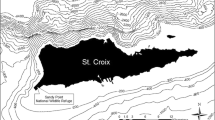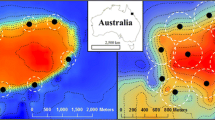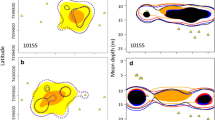Abstract
As historically abundant spongivores, hawksbill turtles Eretmochelys imbricata likely played a key ecological role on coral reefs. However, coral reefs are now experiencing global declines and many hawksbill populations are critically reduced. For endangered species, tracking movement has been recognized as fundamental to management. Since movements in marine vertebrates encompass three dimensions, evaluation of diving behavior and range is required to characterize marine turtle habitat. In this study, habitat use of hawksbill turtles on a Caribbean coral reef was elucidated by quantifying diel depth utilization and movements in relation to the boundaries of marine protected areas. Time depth recorders (TDRs) and ultrasonic tags were deployed on 21 Cayman Islands hawksbills, ranging in size from 26.4 to 58.4 cm straight carapace length. Study animals displayed pronounced diel patterns of diurnal activity and nocturnal resting, where diurnal dives were significantly shorter, deeper, and more active. Mean diurnal dive depth (±SD) was 8 ± 5 m, range 2–20 m, mean nocturnal dive depth was 5 ± 5 m, range 1–14 m, and maximum diurnal dive depth was 43 ± 27 m, range 7–91 m. Larger individuals performed significantly longer dives. Body mass was significantly correlated with mean dive depth for nocturnal but not diurnal dives. However, maximum diurnal dive depth was significantly correlated with body mass, suggesting partitioning of vertical habitat by size. Thus, variable dive capacity may reduce intraspecific competition and provide resistance to degradation in shallow habitats. Larger hawksbills may also represent important predators on deep reefs, creating a broad ecological footprint over a range of depths.








Similar content being viewed by others
References
Baird RW, Borsani JF, Hanson MB, Tyack PL (2002) Diving and night-time behavior of long-finned pilot whales in the Ligurian Sea. Mar Ecol Prog Ser 237:301–305
Balazs GH (1999) Factors to consider in the tagging of sea turtles. In: Eckert KL, Bjorndal KA, Abreu-Grobois FA, Donnelly M (eds) Research and management techniques for the conservation of sea turtles. IUCN/SSC Marine Turtle Specialist Group publication no. 4, pp 101–109
Beggs JA, Horrocks JA, Krueger BH (2007) Increase in hawksbill sea turtle Eretmochelys imbricata nesting in Barbados, West Indies. Endangered Species Research 3:159–168
Bell CD, Blumenthal JM, Austin TJ, Solomon JL, Ebanks-Petrie G, Broderick AC, Godley BJ (2006) Traditional Caymanian fishery may impede local marine turtle population recovery. Endangered Species Research 2:63–69
Bell CD, Solomon JL, Blumenthal JM, Austin TJ, Ebanks-Petrie G, Broderick AC, Godley BJ (2007) Monitoring and conservation of critically reduced marine turtle nesting populations: lessons from the Cayman Islands. Anim Conserv 10(1):39–47
Bell CD, Blumenthal JM, Austin TJ, Ebanks-Petrie G, Broderick AC, Godley BJ (2008) Harnessing recreational divers for the collection of sea turtle data around the Cayman Islands. Tourism in Marine Environments (in press)
Blair SM, McIntosh TL, Mostkoff BJ (1994) Impacts of hurricane Andrew on the offshore reef systems of Central and Northern Dade County, Florida. Bull Mar Sci 54:961–973
Bjorndal KA, Jackson JBC (2003) Roles of sea turtles in marine ecosystems: reconstructing the past. In: Lutz PL, Musick JA, Wyneken J (eds) The biology of sea turtles II. CRC Press, Boca Raton, pp 259–273
Blumenthal JM, Solomon JL, Bell CD, Austin TJ, Ebanks-Petrie G, Coyne MS, Broderick AC, Godley BJ (2006) Satellite tracking highlights the need for international cooperation in marine turtle management. Endangered Species Research 2:51–61
Chaloupka M, Kamezaki N, Limpus C (2008) Is climate change affecting the population dynamics of the endangered Pacific loggerhead sea turtle. J Exp Mar Biol Ecol 356:136–143
Compagno LJV (1984) Sharks of the world. An annotated and illustrated catalogue of shark species known to date. Part 1 - Hexanchiformes to Lamniformes. FAO, Rome
Cooke SJ (2008) Biotelemetry and biologging in endangered species research and animal conservation: relevance to regional, national, and IUCN Red List threat assessment. Endangered Species Research 4:165–185
Croll DA, Acevedo-Gutierrez A, Tershy BR, Urban-Ramirez J (2001) The diving behavior of blue and fin whales: is dive duration shorter than expected based on oxygen stores? Comp Biochem Physiol Part A Mol Integr Physiol 129:797–809
Diez CE, van Dam RP (2002) Habitat effect on hawksbill turtle growth rates on feeding grounds at Mona and Monito Islands, Puerto Rico. Mar Ecol Prog Ser 234:301–309
Eckert SA, Eckert KL, Ponganis P, Kooyman GL (1989) Diving and foraging behavior of leatherback sea turtles (Dermochelys coriacea). Can J Zool 67:2834–2840
Gardner TA, Cote IM, Gill JA, Grant A, Watkinson AR (2003) Long-term region-wide declines in Caribbean corals. Science 301:958–960
Ghiold J, Rountree GA, Smith SH (1994) Common sponges of the Cayman Islands. In: Brunt AM, Davies JE (eds) The Cayman Islands: natural history and biogeography. Kluwer Academic Publishers, Dordrecht, pp 131–138
Godley BJ, Lima E, Akesson S, Broderick AC, Glen F, Godfrey MH, Luschi P, Hays GC (2003) Movement patterns of green turtles in Brazilian coastal waters described by satellite tracking and flipper tagging. Mar Ecol Prog Ser 253:279–288
Godley BJ, Blumenthal JM, Broderick AC, Coyne MS, Godfrey MH, Hawkes LA, Witt MJ (2008) Satellite tracking sea turtles: where have we been and where do we go next? Endangered Species Research 4:3–22
Hays G, Marshall G, Seminoff J (2007) Flipper beat frequency and amplitude changes in diving green turtles, Chelonia mydas. Mar Biol 150:1003–1009
Hays GC, Hochscheid S, Broderick AC, Godley BJ, Metcalfe JD (2000a) Diving behaviour of green turtles: dive depth, dive duration, and activity levels. Mar Ecol Prog Ser 208:297–298
Hays GC, Adams CR, Broderick AC, Godley BJ, Lucas DJ, Metcalfe JD, Prior AA (2000b) The diving behaviour of green turtles at Ascension Island. Anim Behav 59:577–586
Hays GC, Metcalfe JD, Walne AW (2004) The implications of lung-regulated buoyancy control for dive depth and duration. Ecology 85:1137–1145
Hays GC, Hobson VJ, Metcalfe JD, Righton D, Sims DW (2006) Flexible foraging movements of leatherback turtles across the North Atlantic Ocean. Ecology 87:2647–2656
Heithaus MR, Frid A, Dill LM (2002a) Shark-inflicted injury frequencies, escape ability, and habitat use of green and loggerhead turtles. Mar Biol 140:229–236
Heithaus MR, McLash JJ, Frid A, Dill LM, Marshall G (2002b) Novel insights into green sea turtle behaviour using animal-borne video cameras. J Mar Biol Assoc UK 82:1049–1050
Heithaus MR, Frid A, Wirsing AJ, Dill LM, Fourqurean JW, Burkholder D, Thomson J, Bejder OL (2007) State-dependent risk-taking by green sea turtles mediates top-down effects of tiger shark intimidation in a marine ecosystem. J Anim Ecol 76:837–844
Hill MS (1998) Spongivory on Caribbean reefs releases corals from competition with sponges. Oecologia 117:143–150
Hindell MA, Harcourt R, Waas JR, Thompson D (2002) Finescale three-dimensional spatial use by diving, lactating female Weddell seals Leptonychotes weddelli. Mar Ecol Prog Ser 242:275–284
Hochscheid S, McMahon CR, Bradshaw CJA, Maffucci F, Bentivegna F, Hays GC (2007) Allometric scaling of lung volume and its consequences for marine turtle diving performance. Comp Biochem Physiol Part A Mol Integr Physiol 148:360–367
Houghton DR, Callow MJ, Hays GC (2003) Habitat utilization by juvenile hawksbill turtles (Eretmochelys imbricata, Linnaeus, 1766) around a shallow water coral reef. J Nat Hist 37:1269–1280
Hughes TP, Baird AH, Bellwood DR, Card M, Connolly SR, Folke C, Grosberg R, Hoegh-Guldberg O, Jackson JBC, Kleypass J, Lough JM, Marshall P, Nystrom M, Palumbi SR, Pandolfi JM, Rosen B, Roughgarden J (2003) Climate change, human impacts, and the resilience of coral reefs. Science 301:929–933
IUCN (2007) 2007 Red List of Threatened Species. http://www.iucnredlist.org
Jackson JBC, Kirby MX, Berger WH, Bjorndal KA, Botsford LW, Bourque BJ, Bradbury RH, Cooke R, Erlandson J, Estes JA, Hughes TP, Kidwell S, Lange CB, Lenihan HS, Pandolfi JM, Peterson CH, Steneck RS, Tegner MJ, Warner RR (2001) Historical overfishing and the recent collapse of coastal ecosystems. Science 293:629–638
Knowlton (2001) The future of coral reefs. Proc Natl Acad Sci USA 98:5419–5425
Kooyman GL (1975) Comparison between Day and Night Diving in Weddell Seal. J Mammal 56:563–574
Krafft BA, Lydersen C, Gjertz I, Kovacs KM (2002) Diving behaviour of sub-adult harbour seals (Phoca vitulina) at Prins Karls Forland, Svalbard. Polar Biol 25:230–234
Leon YM, Bjorndal KA (2002) Selective feeding in the hawksbill turtle, an important predator in coral reef ecosystems. Mar Ecol Prog Ser 245:249–258
Lutcavage ME, Lutz PL (1997) Diving physiology. In: Lutz PL, Musick JA (eds) The biology of sea turtles. CRC press, Boca Raton, pp 277–296
Lutz PL, Bentley TB (1985) Respiratory physiology of diving in the sea turtle. Copeia 1985:671–679
Makowski C, Seminoff JA, Salmon M (2006) Home range and habitat use of juvenile Atlantic green turtles (Chelonia mydas L.) on shallow reef habitats in Palm Beach, Florida, USA. Mar Biol 148:1167–1179
McGowan A, Broderick AC, Frett G, Gore S, Hastings M, Pickering A, Wheatley D, White J, Witt MJ, Godley BJ (2008) Down but not out: marine turtles of the British Virgin Islands. Anim Cons 11(2):92–103
Mendonca MT, Ehrhart LM (1982) Activity, population size and structure of immature Chelonia mydas and Caretta caretta in Mosquito Lagoon, Florida. Copeia 161–167
Moll RJ, Millspaugh JJ, Beringer J, Sartwell J, He Z (2007) A new ‘view’ of ecology and conservation through animal-bourne video systems. Trends Ecol Evol 22:660–668
Musick JA, Limpus CJ (1997) Habitat utilization and migration in juvenile sea turtles. In: Lutz PL, Musick JA (eds) The biology of sea turtles. CRC Press, Boca Raton, pp 137–164
Pandolfi JM, Bradbury RH, Sala E, Hughes TP, Bjorndal KA, Cooke RG, McArdle D, McClenachan L, Newman MJH, Paredes G, Warner RR, Jackson JBC (2003) Global trajectories of the long-term decline of coral reef ecosystems. Science 301:955–958
Plotkin P (2003) Adult migrations and habitat use. In: Lutz PL, Musick JA, Wyneken J (eds) The biology of sea turtles II. CRC press, Boca Raton, pp 225–241
Polovina JJ, Kobayashi RD, Parker MD, Seki PM, Balazs HG (2000) Turtles on the edge: movement of loggerhead turtles (Caretta caretta) along oceanic fronts, spanning longline fishing grounds in the central North Pacific, 1997–1998. Fish Oceanogr 9:71–82
Reina RD, Abernathy KJ, Marshall GJ, Spotila JR (2005) Respiratory frequency, dive behaviour and social interactions of leatherback turtles, Dermochelys coriacea during the inter-nesting interval. J Exp Mar Biol Ecol 316:1–16
Sakamoto W, Uchida I, Naito Y, Kureha K, Tujimura M, Sato K (1990) Deep diving behavior of the loggerhead turtle near the frontal zone. Nippon Suisan Gakkaishi 56:1435–1443
Schreer JF, Kovacs KM (1997) Allometry of diving capacity in air-breathing vertebrates. Can J Zool 75:339–358
Seminoff J, Jones TT (2006) Diel movements and activity ranges of Green Turtles (Chelonia mydas) at a temperate foraging area in the Gulf of California, Mexico. Herpetological Conservation and Biology 1:81–86
Seminoff JA, Resendiz A, Nichols WJ (2002) Home range of green turtles Chelonia mydas at a coastal foraging area in the Gulf of California, Mexico. Mar Ecol Prog Ser 242:253–265
Seminoff JA, Jones TT, Marshall GJ (2006) Underwater behaviour of green turtles monitored with video-time-depth recorders: what’s missing from dive profiles? Mar Ecol Prog Ser 322:269–280
Simpfendorfer C (2000) Galeocerdo cuvier. 2007 IUCN Red List of Threatened Species. http://www.iucnredlist.org
Simpfendorfer C, Burgess GH (2000) Carcharhinus leucas. 2007 IUCN Red List of Threatened Species. http://www.iucnredlist.org
Storch S (2003) The behaviour of immature and female hawksbill turtle (Eretmochelys imbricata) at sea. PhD thesis, Kiel University, Kiel, p 169
Tremblay Y, Cherel Y (2000) Benthic and pelagic dives: a new foraging behaviour in rockhopper penguins. Mar Ecol Prog Ser 204:257–267
van Dam RP, Diez CE (1996) Diving behavior of immature hawksbills (Eretmochelys imbricata) in a Caribbean cliff wall habitat. Mar Biol 127:171–178
van Dam RP, Diez CE (1997a) Diving behavior of immature hawksbill turtles (Eretmochelys imbricata) in a Caribbean reef habitat. Coral Reefs 16:133–138
van Dam RP, Diez CE (1997b) Surfacing behavior of the marine turtle Eretmochelys imbricata. J Herpetol 31:313–316
van Dam RP, Diez CE (1998) Home range of immature hawksbill turtles (Eretmochelys imbricata (Linnaeus)) at two Caribbean islands. J Exp Mar Biol Ecol 220:15–24
van Dam RP, Diez CE, Colon Balazs GH, LAC McMillan WO, Schroeder B (2008) Sex-specific migration patterns of hawksbill turtles from Mona Island, Puerto Rico. Endangered Species Research 4:85–94
Webster NS (2007) Sponge disease: a global threat? Environ Microbiol 9:1363–1375
Wilson RP, Quintana F (2004) Surface pauses in relation to dive duration in imperial cormorants; how much time for a breather? J Exp Biol 207:1789–1796
Wilson RP, Shepard ELC, Liebsch N (2008) Prying into the intimate details of animal lives: use of a daily diary on animals. Endangered Species Research 4:123–137
Woodley JD, Chornesky EA, Clifford PA, Jackson JBC, Kaufman LS, Knowlton N, Lang JC, Pearson MP, Porter JW, Rooney MC (1981) Hurricane Allen’s impact on Jamaican coral reefs. Science 214:749–755
Wulff JL (1995) Effects of a Hurricane on survival and orientation of large erect coral reef sponges. Coral Reefs 14:55–61
Wulff JL (2006) Rapid diversity and abundance decline in a Caribbean coral reef sponge community. Biol Conserv 127:167–176
Acknowledgments
For generously sharing the use of ultrasonic equipment, we thank B. Semmens, S. and S. Heppell, L. Whalen, B. Johnson, P. Bush, C. McCoy, and K. Luke of the Grouper Moon Project—a collaborative effort between REEF and the Cayman Islands Department of Environment with funding provided by the NOAA International Coral Reef Conservation Program and PADI Project AWARE. We thank M. Slattery and the NOAA Twilight Zone Expedition Team for their insights and for providing the image used in Fig. 6. For invaluable logistical support and assistance with fieldwork, we thank J. Mills, P. Lopez, K. Donnawell, and Department of Environment administration, operations, and enforcement staff. Work in the Cayman Islands was supported by the National Environment Research Council (NERC) and the Darwin Initiative, and work in the UK was supported by the European Social Fund. We acknowledge support to J. Blumenthal (University of Exeter postgraduate studentship and the Darwin Initiative) and M. Witt (NERC Postgraduate studentship) and thank anonymous reviewers for input which improved the manuscript.
Author information
Authors and Affiliations
Corresponding author
Additional information
Communicated by Biology Editor Dr Mark McCormick
Rights and permissions
About this article
Cite this article
Blumenthal, J.M., Austin, T.J., Bothwell, J.B. et al. Diving behavior and movements of juvenile hawksbill turtles Eretmochelys imbricata on a Caribbean coral reef. Coral Reefs 28, 55–65 (2009). https://doi.org/10.1007/s00338-008-0416-1
Received:
Revised:
Accepted:
Published:
Issue Date:
DOI: https://doi.org/10.1007/s00338-008-0416-1




